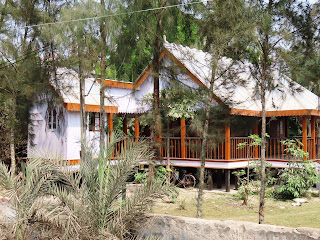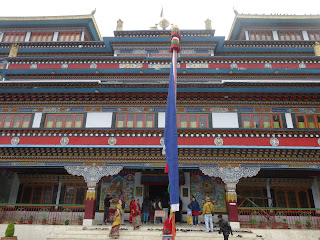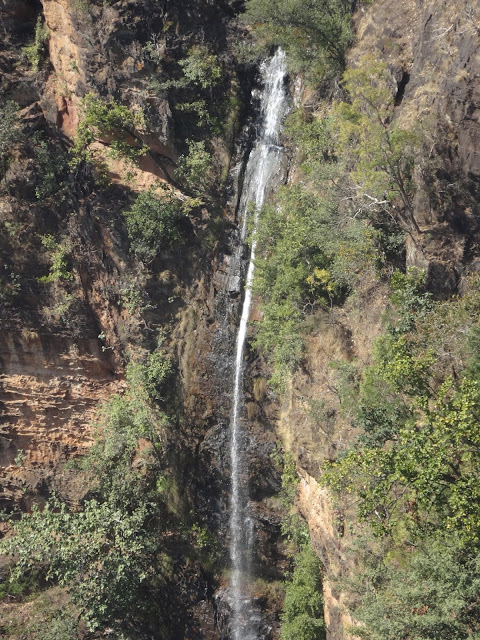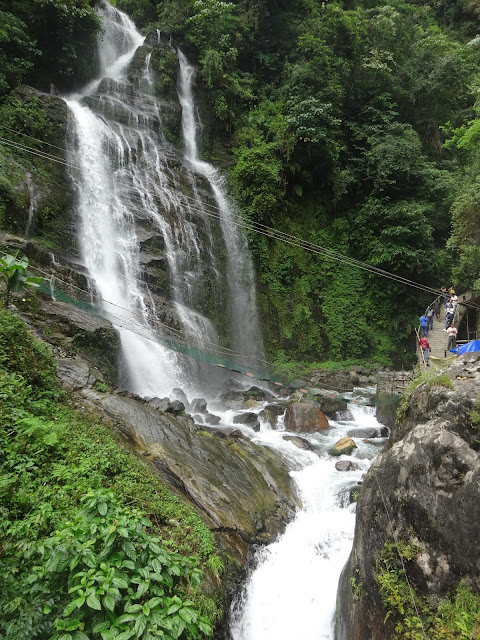Stories
of three forgotten Bungalows of British India:
Every house has its own history. Each home is a dream to its owners. Here are stories of three famous bungalows of British India. Far away from the city, far far away from the crowd, in the lap of Mother Nature, surrounded by blue mountains and green forests the bungalows sre standing and saying their stories.
British Dak Bungalow, Rinchenpong, Sikkim:

British Dak bungalow at Rinchenpong
This British Heritage Bungalow is similar to the other bungalows from the British era and is uniquely furnished in wood and stones. The Rinchenpong bungalow is surrounded by thriving luscious green forest. The Bungalow is quite spacious with two rooms and a wide portico with a beautiful garden. There is a snug well furnished wooden sitting area with a warm fireplace for the guests. Guests can also order food from restaurants located nearby or the Chowkidar and caretaker can prepare some sumptuous local dishes.
 |
| Entrance of Rinchenpong Dak Bungalow |
Situated in the Western region of Sikkim, Rinchenpong has been of great prominence during the colonial years. The British forces in their usual conquest for expansion sent an expeditionary force to Sikkim in 1860, following which the Lepcha natives of this region determined to protect their land from foreign invaders poisoned the water of a pond with some poisonous herbs that killed almost half the Army. This resulted in the retreat of the British army and thus the pond since then came to be known as the famous Bikh Pokhri (poison lake). History apart, Rinchenpong is famous for its breathtaking and enchanting view of the Mt. Kanchenjunga range and some important monasteries. The Himalayan forest vegetation is very lush here and boasts some rare and exotic species of beautiful birds and butterfly thriving in abundance. It is approximately situated at an altitude of about 5576 feet.
 |
| Garden of Rinchenpong Dak Bungalow |
How to reach Rinchenpong British Dak Bungalow:
Rinchenpong is situated about 130 kilometers from Bagdogra Airport (IXB) and New Jalpaiguri Railway Station in West Bengal. One can also go via Siliguri. You can hire a taxi from NJP Railway Station or from Bagdogra Airport to reach rinchenpong via Jorethang. If you are looking for shared transport, then you can take any car or bus from Siliguri to Jorethang and then hire a taxi to Rinchenpong.
Hamilton’s Bungalow, Gosaba, West Bengal:
Hamilton Bungalow in Gosaba is marked as one of the most visited places of every Sundarban package not only due to its historical evidence but also because the house was specially constructed for the Rabindranath Tagore. Tagore stayed in when he went to visit Gosaba, in the Sundarbans, in December 1932. Built on stilts the structure of the house has till the present time proven to be a skillfully designed piece for restraining the force of various cyclones and storms of an extremely high disaster causing violence. Being an area always held at a top position in the radar of typical natural weather disasters, several solid buildings and constructions have even been destroyed owing to the calamities the region was exposed too. Whereas this house has remained as it is and polished. The theory goes that the gap between the earth and the floor allows the winds to pass through without causing serious structural damage. Sir Hamilton is the ultimate person responsible for framing and structuring the massive island as arable. Sir Daniel had many odd and interesting ideas (some might call him a visionary crackpot). He envisaged Gosaba as an agricultural (and educational) co-operative and Tagore was influenced by his ideas.
 |
| Statue of Rabindranath Tagore in front of Hamilton's Bangalow |
How to reach Hamiltons Bungalow:
From Kolkata it’s a three hours drive to Godkhali. From Godkhali jetty you have to go to Gosaba Jetty. The bungalow is located very close to the jetty.
Lord Canning’s House, Canning, West Bengal:
British Governor General Lord Canning established this house at the southern bank of River Matla. He wanted to establish a port that would be alternative to Kolkata and rival of Singapore. The surrounding area is now known as Canning..a subdivision of South 24 Parganas, West Bengal..It is even marked on Google maps “the former residence of British India's last Governor-General and first Viceroy Lord Canning”.
 |
| Remnants Of Lord Canning's House |
The Hooghly River had been the lifeblood of commerce in Bengal since the first European trading ships made their way up the river. As the depth of the river decreased with silting, ships would find it more and more difficult to travel up the river, and Calcutta’s port would get choked. Once the sepoy mutiny of 1857 had been suppressed, the government finally turned its attention to developing a new port in the Sundarban area. A team sent to survey the Matla River in the Sunderbans reported that a spot near the junction of the Bidyadhari and Matla rivers would be an ideal location for the new port. This was to be Port Canning, named after the then Governor General, Lord Canning, since he was the one behind the economic reorganization of India following 1857. On 1st November, 1867, a cyclone made landfall in South Bengal, passing over Port Canning with “fearful violence”. Some 90 people and 500 heads of cattle were reported lost and even the survivors suffered greatly for want of drinking water, since everything, including wells, had been inundated by sea water. The port and the town had been reduced to a “bleached skeleton”.
How to reach Lord Canning’s House:
Board down Canning Local and get down at Canning station. Take a toto or rickshaw to reach this property.
Picture Couirtesy: Kaustav Chakraborty
Sumanata Dutta Banik
Information: Sikkim Tourism and Concrete Paparazzi


























